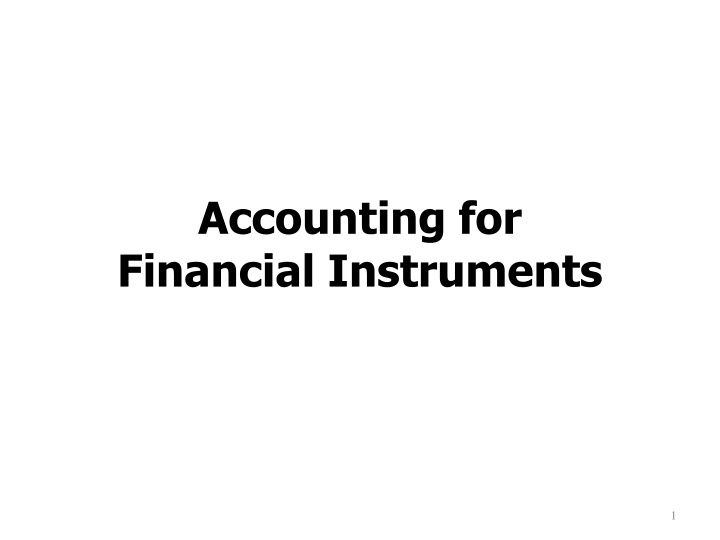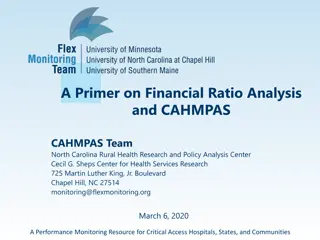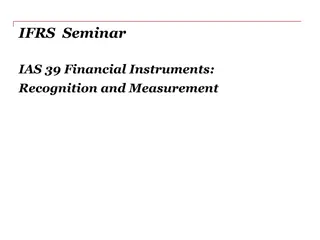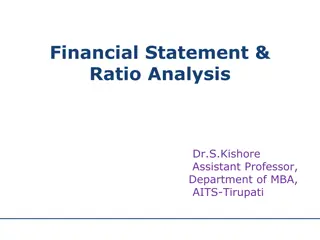
Accounting for Financial Instruments
Explore the world of financial instruments, including SLFRS 9, recognition and measurement of financial instruments, types of financial assets, and measurement categories. Learn about contracts giving rise to financial assets or liabilities, primary types of financial instruments, and more.
Download Presentation

Please find below an Image/Link to download the presentation.
The content on the website is provided AS IS for your information and personal use only. It may not be sold, licensed, or shared on other websites without obtaining consent from the author. If you encounter any issues during the download, it is possible that the publisher has removed the file from their server.
You are allowed to download the files provided on this website for personal or commercial use, subject to the condition that they are used lawfully. All files are the property of their respective owners.
The content on the website is provided AS IS for your information and personal use only. It may not be sold, licensed, or shared on other websites without obtaining consent from the author.
E N D
Presentation Transcript
Accounting for Financial Instruments 1
SLFRS 9 Financial Instruments (Replacement of LKAS 39) LKAS 39 Financial Instruments: Recognition and Measurement LKAS 32 Financial Instruments: Presentation SLFRS 7 Financial Instruments: Disclosures Accounting Standards on Financial Instruments 2
Financial Instrument Any contract that gives rise to both a financial asset of one entity and financial liability or equity instrument of another entity. 3
e.g. deposits of cash, debt investments, equity investments, receivables/payables Primary Types of Financial Instruments e.g. options, forwards/futures, swaps, caps and collars Derivative e.g. convertible bonds, equity indexed notes, exchangeable debt Compound 4
Financial Asset Is any asset that is: a) Cash; b) An equity instrument of another entity; c) A contractual right: i. to receive cash or another financial asset from another entity; or ii. to exchange financial assets or financial liabilities with another entity under conditions that are potentially favourable to the entity: or 5
Types of Financial Assets 1. Financial assets at fair value through profit or loss - financial assets that are either classified as held for trading; or are designated as such on initial recognition. Held-to-maturity investments - financial assets with fixed or determinable payments and fixed maturity, other than loans and receivables, for which there is a positive intention and ability to hold to maturity and which have not been designated as financial assets at fair value through profit or loss or as available-for-sale. Loans and receivables non-derivative financial assets with fixed or determinable payments that are not quoted in an active market and do not qualify as tradingassets and have not designated as financial assets at fair value through profit or loss or as available- for-sale. Available-for-sale financial assets - non-derivative financial assets that are designated as available-for-sale or are not classified as loans and receivables , held-to-maturity investments , or financial assets at fair value through profit or loss . 2. 3. 4. 6
Measurement of Financial Assets Category Basis for subsequent measurement Changes in carrying amount is recognized in : Financial assets at fair value through profit or loss Fair value Profit or Loss Available-for-sale financial assets Fair value Other comprehensive income Held-to-maturity investments Loans and receivables Amortized cost Profit or Loss Amortized cost Profit or Loss 7
Financial Liability Is any liability that is: a) a contractual obligation: i. to deliver cash or another financial asset to another entity; or ii. to exchange financial assets or financial liabilities with another entity under conditions that are potentially unfavourable to the entity; or 8
Equity Instrument Any contract that evidences a residual interest in the assets of an entity after deducting all its liabilities. 9
Presentation of Financial Instruments The issuer of a financial instrument should classify it or its component parts, on initial recognition as a financial liability, a financial asset or an equity instrument in accordance with the substance of the contractual arrangement and definitions of these instruments. 10
Critical Features - Differentiating between Financial Liabilities and Equity Contractual payment obligations e.g. Interest payments, repayment of debt Contractual components of a financial instrument that creates a financial liability of the entity e.g. convertible bonds 11
Compound Financial Instruments Financial instruments that contain both a liability and an equity component. Such components shall be classified separately as financial liabilities, financial assets or equity instruments. Amounts allocated to these debt and equity two components are based on their relative fair values at issuance. 12
Conversion of a Convertible Instrument at Maturity The entity derecognizes the liability component and recognizes it as equity. The original equity component remains as equity. There is no gain or loss on conversion on maturity. 13
Interest, Dividends, Losses and Gains If relating to a financial liability If relating to an equity instrument Recognized in income or expense in profit or loss net of any related income tax benefit. Debited directly to equity net of any related income tax benefit. 14
Derivative A financial instrument with all three of the following characteristics: Its value changes in response to the change in a specified rate or price (underlying instrument) It requires no initial investment or an initial net investment. It is settled at a future date. 15
Share Options Call Option Put Option Right to buy shares at a specified price (exercise/strike price) within a specified period (The option period). Right to sell shares at a specified price (exercise/strike price) within a specified period (The option period). 16
Embedded Derivative A component of a hybrid (combined) instrument that also includes a non-derivative host contract with the effect that some of the cash flows of the combined instrument vary in a way similar to a stand-alone derivative. It is a derivative embedded in a host contract. (e.g. put option in a debt instrument, interest rate swap embedded in a debt instrument ) 17






















